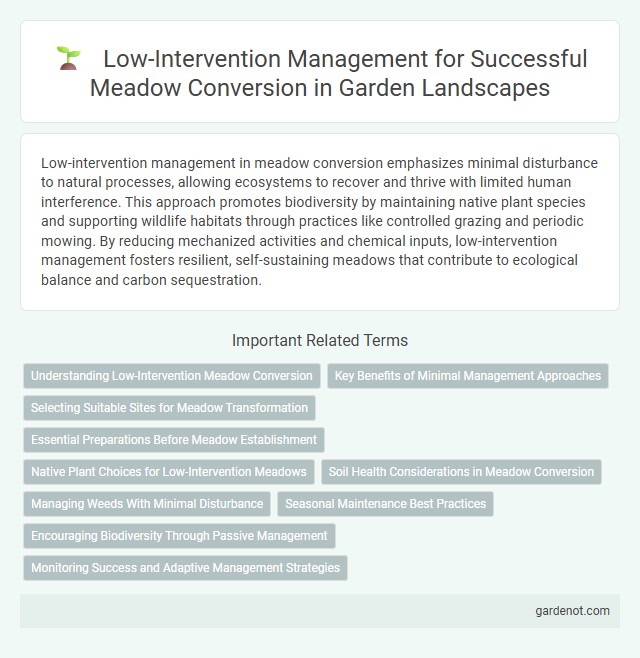Low-intervention management in meadow conversion emphasizes minimal disturbance to natural processes, allowing ecosystems to recover and thrive with limited human interference. This approach promotes biodiversity by maintaining native plant species and supporting wildlife habitats through practices like controlled grazing and periodic mowing. By reducing mechanized activities and chemical inputs, low-intervention management fosters resilient, self-sustaining meadows that contribute to ecological balance and carbon sequestration.
Understanding Low-Intervention Meadow Conversion
Low-intervention meadow conversion prioritizes natural processes and minimal human interference to restore and maintain biodiversity-rich habitats. This approach emphasizes native species establishment, soil health preservation, and seasonal mowing tailored to ecological cycles rather than intensive agricultural practices. Understanding low-intervention meadow conversion aids in promoting resilient ecosystems that support pollinators, ground-nesting birds, and diverse plant communities.
Key Benefits of Minimal Management Approaches
Low-intervention management in meadow conversion enhances biodiversity by allowing native species to establish without frequent human disruption, promoting ecological balance and habitat complexity. This method reduces resource inputs like water, labor, and chemicals, fostering sustainable land use while supporting pollinators and soil health. Minimal management also strengthens ecosystem resilience, improving the meadow's ability to recover from environmental stresses naturally.
Selecting Suitable Sites for Meadow Transformation
Selecting suitable sites for meadow conversion is crucial to ensure successful low-intervention management, emphasizing areas with native soil profiles and pre-existing grassland biodiversity. Prioritize locations with minimal invasive species presence and appropriate hydrological conditions to support natural seed germination and growth. Site selection directly influences long-term ecological stability, reducing the need for active maintenance and enhancing habitat resilience.
Essential Preparations Before Meadow Establishment
Low-intervention management in meadow conversion prioritizes minimal disturbance by ensuring essential preparations such as soil testing, removal of invasive species, and selection of native seed mixes suited to local conditions. Proper site assessment optimizes soil fertility and pH, promoting sustainable growth without intensive input. Establishing clear objectives and timelines enhances natural biodiversity while reducing reliance on chemical treatments.
Native Plant Choices for Low-Intervention Meadows
Low-intervention meadow management prioritizes native plant species such as big bluestem, purple coneflower, and little bluestem, which require minimal maintenance while promoting biodiversity. Emphasizing deep-rooted perennials enhances soil health and resilience against erosion and drought. Native plants support local pollinators and wildlife, creating sustainable ecosystems with reduced need for watering, fertilizing, or mowing.
Soil Health Considerations in Meadow Conversion
Low-intervention management in meadow conversion emphasizes enhancing soil health by minimizing mechanical disturbance and preserving organic matter layers. Maintaining diverse plant species promotes root biomass that enriches soil microbial activity and nutrient cycling. Applying mulch and avoiding chemical inputs supports natural soil structure, increasing water retention and aeration essential for ecosystem resilience.
Managing Weeds With Minimal Disturbance
Low-intervention management in meadow conversion emphasizes controlling weeds through minimal soil disturbance to preserve native plant communities and soil health. Techniques include selective mowing, hand-weeding, and targeted grazing to reduce weed dominance without disrupting beneficial organisms or seed banks. Maintaining this balance supports biodiversity, enhances ecological resilience, and promotes sustainable meadow restoration.
Seasonal Maintenance Best Practices
Low-intervention meadow management prioritizes minimal disturbance, allowing native flora to thrive through natural growth cycles. Seasonal maintenance practices include timed mowing and selective removal of invasive species to support biodiversity while preserving habitat structure. Emphasizing these methods enhances ecosystem resilience and promotes long-term sustainability of meadow environments.
Encouraging Biodiversity Through Passive Management
Low-intervention management in meadow conversion prioritizes natural processes by minimizing human disturbance, allowing native flora and fauna to thrive. Encouraging biodiversity through passive management enhances ecosystem resilience and supports diverse habitats for pollinators, birds, and other wildlife. This approach reduces maintenance costs while promoting sustainable, self-regulating meadow ecosystems.
Monitoring Success and Adaptive Management Strategies
Low-intervention management in meadow conversion emphasizes continuous monitoring of vegetation composition, soil health, and biodiversity indicators to assess ecological progress. Success is gauged through metrics such as native species cover, pollinator activity, and habitat connectivity, guiding timely adjustments in management practices. Adaptive strategies may include modifying grazing intensity, controlling invasive species, or adjusting mowing regimes to promote desired meadow dynamics and resilience.
Low-intervention management Infographic

 gardenot.com
gardenot.com